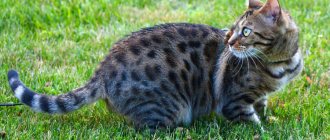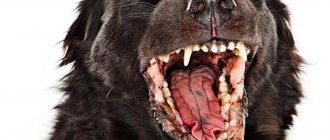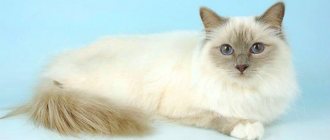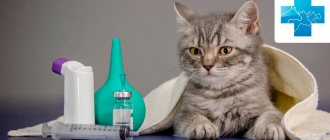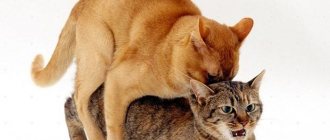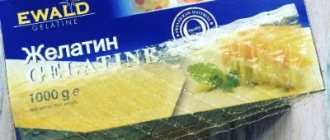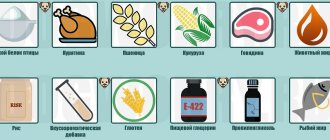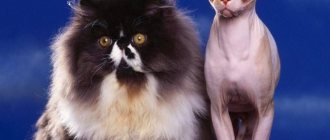Origin of the breed
There are several versions of the appearance of the Turkish Vans. The most popular legend dates back to the time of the Flood. According to it, after Noah took two white cats into the ark and landed on the shores near Mount Ararat, the animals descended to earth and became the progenitors of the entire cat family on earth. In the Van region, which belongs to modern Turkey, the remains of representatives of this breed were found, which lived here for many thousands of years. In addition to Turkey, these varieties live in Iraq, Syria, Iran, Armenia, and are actively spreading.
Turc de Van
It is believed that the proximity to Lake Van gave the animals the ability to swim. This is one of the highest lakes in the world, and the area is famous for its extreme temperatures. In order not to freeze in winter and easily cope with difficulties, the Turkish van has adapted over time. Light wool allows them to float well and withstand heat. The structure of their coat allows them to emerge from the water almost dry. In winter, the undercoat becomes thicker, and they easily get used to the cold. That is why, regardless of climatic conditions, anyone can become the owner of a Turkish van.
When archaeologists explored the region that gave the name to this breed, they found many artifacts depicting representatives of this family. Many finds date back to the 2nd millennium BC. Perhaps this is one of the most ancient breeds in the world.
It is interesting that if the Turks had not captured part of the territory of Armenia, where Lake Van is located, the cats would not have been called “Turkish”, but “Armenian”. In Armenia they are highly valued for their flexible nature.
If animals were brought to Europe by the crusaders, then they explored the Middle East together with traders. The modern history of such cats began in 1955, when British journalists went to Turkey to prepare a program about the country, meeting representatives of an unusual feline species there. One of the journalists was then given two red and white kittens. In 1959, the couple was joined by a cat named Anatolia (which is why the Turkish Van is also known as the Anatolian).
Cats arrived in the United States in 1970, but did not become popular until 1983. A couple of years later, the International Cat Association recognizes Turkish Vans as full-fledged representatives of the breed.
In 1992, the media reported that only 92 original Turkish Vans had been discovered in their homeland. As a result, the government developed a program to protect animals and preserve the species. Today, such cats are a national treasure, and their import is prohibited. This creates a number of difficulties in terms of breeding animals, since there are quite a few of them in the USA and Europe.
Purchasing a Turkish Van kitten
There are very few nurseries in Russia that breed this breed. Some connoisseurs and breeders bring a kitten directly from Turkey, but this is expensive, and a special veterinary certificate is required for export. And also the cost of a kitten depends on its external characteristics and pedigree. Even if you managed to find a kitten in your city, the price for it can be higher than 20,000 rubles. Some breeders value their Vans at several thousand dollars.
Of course, for breeding and participation in exhibitions you need a purebred cat. For such cases, it is better to order it from foreign nurseries. But I would rather wait for such a kitten to appear in my city (or just in Russia). I often hear stories about how lucky someone is. After all, sometimes professionals keep purebred kittens, but the breeder himself cannot breed and he has to give the babies into “good hands” (sometimes for a nominal fee).
Finding Turkish Van kittens in Russia is not so easy
Criteria for choosing a Turkish kitten
If you find a kitten abroad, then it will definitely have all the necessary documents, all you have to do is go and pick it up. Moreover, it is unlikely that the customer will abandon the baby after a long wait and travel costs. Therefore, adhering to the criteria is especially important for those people who will personally visit the breeder/kennel in order to choose a kitten. The main criteria are the following factors:
- reputation of the nursery/breeder (website availability, positive reviews, recommendations, etc.);
- the appearance of the kitten, as well as other animals (they must be well-groomed);
- documentation.
The breeder must provide a veterinary passport for the kitten. The document must contain vaccination records with the date, a holographic sticker and the veterinarian's signature. If the owner does not offer it himself, then you can ask for the baby’s pedigree. The ideal option is if the breeder also provides a pedigree for the kitten’s parents (the more relatives of the animal are known, the better). And sometimes an agreement is concluded between the breeder and the buyer. This is a kind of agreement that specifies the price, conditions for transferring the animal, the rights and obligations of the parties. The agreement may also contain a clause on mandatory conditions for the future maintenance of the animal.
When I took the animal from the nursery, they gave me a veterinary passport (there was no pedigree, because the cat was not purebred) and some kind of certificate about the health of the kitten. In addition, the breeders gave us a magnet with a photo of the animal and a calendar. And when we left, they brought a package of dry food and a kitten’s bowl into our car.
Video: Turkish Van cat kittens
At what age is it better to adopt a kitten?
If you have found the ideal kitten and you are satisfied with everything, then you cannot immediately take the baby while he is still very small. Veterinarians recommend adopting cats no younger than three months of age. There are several explanations for this limitation:
- Up to three months, kittens receive mandatory vaccinations (if you pick up the cat earlier, you will have to do the vaccination yourself).
- A small kitten receives primary immunity from the cat's milk (if taken earlier, the kitten will be sick).
- From the first days, the cat teaches the kittens how to go to the toilet, eat and play (if you tear the baby away from the cat earlier, problems with the pet’s behavior may arise).
In general, experienced breeders will not give away a younger kitten. Especially if the nursery professionally breeds the breed. After all, putting a baby in inexperienced hands means losing a representative of the breed. In the world of breeders, every purebred individual is valued.
There is one exception. A cat can be adopted even at a week old if it is left without a wet nurse. In this case, it will require special care. For an unfamiliar breeder to give you such a baby, you must inspire trust in him.
Photo gallery: Turkish Van kittens
some people take in several kittens at once so they don't get bored
no one can feed kittens better than a mother cat
A Van baby may miss his mother if he is taken away early
after three months, kittens are more independent
Appearance description
The color appearance varies from red-chestnut to white. But it is believed that the snow-white pattern of a purebred animal should not occupy more than 80% of the surface. Tortoiseshell, blue, black, and cream colors are also popular. Currently, white cats of this breed are recognized by TICA and other associations, although with minor reservations. They are considered mestizos and crosses with Angora varieties. Currently, most associations recognize peach, blue, black and tri-colors in addition to the traditional coat color.
In winter, the cat's fur becomes thicker throughout the body, with the exception of the head. Its structure is similar to cashmere and does not retain water.
What do Turkish Van kittens look like?
Turkish Van kittens are born with rather sparse fur, and only as they grow older do their coats acquire luxurious volume. In winter, the coat is long and thick; in summer, they become more like short-haired pets.
A beautiful kitten of this breed is very active and playful. The owner should devote as much time as possible to the baby in gameplay. This will allow you to raise a kind cat with a cheerful character.
Kittens are born with the appearance features characteristic of this breed and are almost no different from their adult relatives. The final color of the coat and eyes is formed from the first days of life, which is due to the hemizygosity of their purebred genotype.
When buying a Turkish Van kitten, pay attention to the coat color. Even for a small pet, it will be plain white without different markings or with characteristic inserts of acceptable colors. In most cases, spots are present on the head, around the ears and on the tail. Small blotches on the back of the animal are also possible.
Breed standard
The Van cat immediately impresses with its size. Adult cats can weigh up to 10 kg. The weight of cats is less - 5 kg. Other characteristics:
- head of medium or large size, with pronounced cheekbones, but rounded features;
- large eyes reminiscent of peach pits, almonds, planted at an angle;
- eyes amber, blue;
- sometimes a kitten has a different eye shade;
- the Javanese species has green eyes;
- well developed body;
- medium-length wool, without a pronounced undercoat (it becomes thicker in winter);
- height – about 35-40 cm at the withers;
- length from the end of the tail to the nose – 90-120 cm;
- strong limbs with a little fluff between the toes;
- the bridge of the nose stands out, the nose itself is not very long;
- the tail looks like a brush.
Minuses
- —curiosity killed the cat—it’s about them
- — they love heights and more and more new toys
Turkish Vans are quite large cats with an original appearance, soft fur and a cheerful disposition. They love to play and swim, have no health problems and, with proper care, are not dangerous for people with allergies.
Story
According to genetic studies, the Turkish Van is one of the oldest breeds of domestic cats. This breed arose and developed naturally, without any human intervention.
Legend Noah built the ark to save his chosen people and animals from the flood. And the devil created a mouse so that it would gnaw a hole in the bottom of the ark. Then God blessed the cat to kill the mouse created by the devil. The cat completed the task, and thereby saved all of humanity. As a sign of gratitude, God blessed the cat by touching it with his hand. This is how Van cats developed a characteristic spot on their left shoulder in the shape of a human fingerprint. The Kurds call it “the mark of the thumb of the right hand of Allah.” Until now, many Van cats are born with this spot.
It is believed that the first Van cats could have come to Western Europe with the Crusaders returning from the Crusades. In their homeland, these cats were known as “vana katu”, which is translated from Armenian as “Vana cat”. The word "van" is widespread in the Armenian Highlands region. In Armenian, “van” is a village, an inhabited place. The same word is used to describe Lake Van, the fourth largest lake in the world. At different times, the territories around Lake Van were part of the state of Urartu, Greater Armenia, the Parthian Kingdom, the Roman and Ottoman Empires. During the collapse of the Ottoman Empire (1915 - 1918), the Armenian population of this region was partially evicted and partially destroyed. Kurds settled around Lake Van. And only Van cats have not gone away. In Europe, when people did not yet bother dividing cats into certain breeds, Turkish Vans were called either Russian longhaired or white ring-tailed. But most often they were considered Angora cats with a special color. Today we know that Angora cats and Turkish Vans are different breeds, differing from each other both in origin and in external features.
The earliest depiction of a typical Van cat in Western European painting can be considered the painting “Lady with a Cat” by the French artist Marguerite Gerard:
"Lady with a Cat", Marguerite Gerard (1761-1837)
European travelers who visited Western Armenia since the 17th century repeatedly mentioned and described these cats. In particular, the French archaeologist, architect and artist Pierre Victor Lottin de Laval, who traveled through the territories located between Ankara and Baghdad, gave the following description: “I myself met specimens of this beautiful breed of cats on the large Armenian plateau in Erzurum, where the climate is very different from the climate of Angora. This breed is very numerous in Murcha in Kurdistan, where it is the dominant variety. I also met them in Bitlis and the Pashalik of Bayazet. However, the best examples I saw belonged to the Archbishop of Van, a city in eastern Kurdistan, on the border with Azerbaijan. He had three of these cats: one was pearl gray, another was orange with black and white spots, and the third was completely white. Their fur was magnificent, although no one was surprised by them, since such cats are widespread in Kurdistan. I also saw several of these cats in the residence of Khan Mahmud, Prince of Ghekiars, in Alpeit.”
Most Van cats were exported to the West under the guise of Angora cats, and even Vans with a typical Van color were called white Angora cats. For example, the painting “Girl with a White Cat” by the French artist Antoine Jean Bayle depicts a typical Van cat:
"Girl with a White Cat", Antoine Jean Bayle (1830-1918)
In the summer of 1955, British journalist Laura Lushington took two kittens from Turkey - a boy and a girl. She was given a girl in Eastern Anatolia, and a boy in Istanbul. The cat was named Van Atilla, and the cat was named Van Güzeli Iskenderun. Even on the way to London, the kittens showed themselves in the most unexpected way - however, characteristic of all Vanir. Laura stopped the car near the river to take a break from the heat in the shade of the trees. While Laura was washing herself in the river, the kittens got out of the car and rushed into the water. They swam, and swimming in the water gave them obvious pleasure! With the light hand of Laura Lushington, the English press nicknamed the Vanir “waterfowl cats.”
Features of color
The main difference between the breed is the colored spots on a white background. Patterns and shades vary. Sprinkles of white are acceptable at the tip of the tail. The most popular pattern is tabby stripes.
Followers of Islam believe that Allah himself left these marks on the cat, blessing it to fight rodents that were supposed to destroy Noah's ark. Markings are most often cream, red, blue, and black. The paw pads and nose of this breed are usually pink.
Appearance
The Turkish Van is a very beautiful, rather large cat with an original color and soft wool similar to cashmere. The length from the tip of the nose to the tail is 90-120 cm, and the height at the shoulders is about 38 cm. Sexual dimorphism is very well expressed.
- The weight of cats is 6-9 kg.
- Cats weight: 4.5-6 kg.
The head is wedge-shaped. The profile is almost straight. The distance between the ears is approximately three fingers. The ears are medium in size, set high, wide at the base with rounded tips. The auricle is well furred inside. Turkish Vans have unusually beautiful eyes, large and slanted. Color blue, amber or copper. Heterochromia is common.
The body is muscular, elongated. The back is rectangular, slightly tapering towards the tail. The legs are of medium length, the front legs are slightly longer than the hind legs. The paws are round, with tufts of hair between the toes. The tail is long and well furred.
With age, the coat becomes thicker and more voluminous. Turkish Vans reach full maturity at the age of 3-5 years. This is worth considering as the standard describes adult mature cats.
Wool deserves special attention. The guard hair is medium long, snow-white, not prone to tangles and yellowing, has self-cleaning properties and is very pleasant to the touch, reminiscent of cashmere. There are different lengths of hair on different parts of the body. There is no undercoat. Classic color: the white coat is distinguished by red-chestnut spots located on the head. The same color is a beautiful fluffy tail, on which you can see 5-8 clear rings. Small markings are allowed on the back, usually in the area of the shoulder blades. White color must be at least 80%. Some felinological organizations also recognize other colors with or without similar placement of spots:
- Completely white;
- Black;
- Blue;
- Cream;
- Tortoiseshell;
- Blue tortoiseshell tabby.
WCF and CFA recognize the Turkish Van cat only in the classic color (white with red-brown spots), and FIFE, TICA and lesser organizations also recognize other colors (black and white, tortoiseshell, etc.)
Character, relationships with children, adults and other animals
As for character, Van has an active, lively disposition. This cute animal is capable of displays of tenderness and loves attention from its owners. They like to climb onto high shelves or cabinets and watch what is happening from there. Van needs to devote a lot of time, since he is actively involved in games, and does not tolerate loneliness well.
The Vans demand attention. They usually choose one leader for themselves, although they behave kindly with other family members. The animal is ready to share everything with the owner, but he, in turn, must devote free time to her. These breeds are very jealous. This is why they do not get along well with other pets. Although, with the right approach, a van can even live in the same house with a dog. But he will be jealous.
It is important to take into account that the Van does not really like to be squeezed and stroked. Therefore, it is difficult for him to get along with small children. He may even bite or scratch the child if he gets too playful or wants to break free.
Castration and sterilization of Turkish Van cats
Veterinarians and breeders agreed on one thing: if a cat cannot be bred, then it must be sterilized. Sterilization/castration is the removal of an animal's reproductive glands. This way, the pet will not be able to have children, but the cat will not ask to be with the cat, and the cat will not mark its territory. Neutered cats are less likely to develop gynecologic diseases.
Before the procedure, you must undergo tests. The operation is performed under general (cats) and local (cats) anesthesia. The intervention itself lasts about 5–10 minutes, after which the animal is sent home.
Males can be neutered after puberty. In the case of cats, the situation is a little different. Some people spay their cat from the moment she starts estrus. However, it is recommended to operate on the pet when all the internal organs have already formed. Otherwise, the cat may stop growing after surgery.
Video: how to care for a cat after surgery
Features of care and health
Remember that the peculiarity of the Van is its playful and lively character. If the animal is not too active, you should be wary, because this is how diseases often manifest themselves. On average, representatives of this breed live up to 15 years. He has no hereditary defects, but he has heart problems. To maintain immunity and normal development, it is important to monitor your diet, saturating it with protein and carbohydrates.
Since the Van has a small amount of undercoat, it is enough to comb the animal once a week. Bathing is also optional, although cats themselves sometimes ask to wash them because they love water. Ears and eyes should be cleaned as needed. Teeth should be thoroughly brushed to avoid periodontal disease - it is advisable to carry out this procedure at the veterinarian 1-2 times a month. Also keep in mind that the Van has long hair, which will get dirty if you do not keep the tray clean.
As for nutrition, dry food is suitable, but it is important to ensure that there is a bowl of water next to the main food for better digestion. You can also feed your cat meat. When refusing artificial food, it is important to ensure that meat food makes up 80% of the animal’s total diet. It is better to choose lean varieties of chicken and beef. It is also acceptable to include offal, vegetables, fermented milk products, and cereals in the menu. Lack of meat in the diet leads to heart disease, vision problems and poor blood clotting. If the animal’s fur has become dull, it means there is a lack of amino acids, and the diet needs to be adjusted urgently. It is also recommended to take vitamin complexes, which the veterinarian will recommend.
Vitamins A and E are important for Van. A cat can get them by eating cod liver, herbs and oils, which can be added to meat and porridge. You can also plant cereal sprouts (such as oats). The animal will eat this grass with pleasure.
Care
The Van cat breed does not require any special care. The coat should be combed every 3-4 days, but this is not difficult, because it practically does not get tangled. Also, don’t forget to clean your ears, eyes and teeth.
Cat care must also include water treatments. Washing a cat in the bathroom is not difficult, just give the animal the opportunity to have fun and enjoy the process.
What the Turkish Van cat is especially picky about is the cleanliness of his litter box; he basically won’t go into a dirty one, so you need to watch this especially carefully.
Feeding
The Turkish Van cat is a predator whose homeland is the lake, so the best food for it is fish. This is the main component of the animal's diet. But do not forget that such pets also need meat and dairy products.
Van cat cost
Acquiring a representative of this breed is not an easy task. There are very few breeders in Russia and neighboring countries, and the cost of cats is quite high. Here it is important to carefully study the reviews and pedigree. The seller is obliged to provide a passport of the kitten’s parents, documents certifying that the animal belongs to the breed.
The average cost of a small kitten in Russia starts from 10,000-20,000 rubles and is much higher depending on the pedigree. The cost will include the cost of preparing the pet for shipment and issuing certificates, since most often it is brought from abroad.
Even in Turkey, Vans should only be purchased from official breeders; their price in their historical homeland starts from a thousand dollars. It’s better to go look at the kittens with a specialist. But you can also explore the issue yourself and take into account the following details:
- Almost equal rings of two colors should run along the kitten’s tail;
- the presence of small spots on the back is acceptable;
- There are purebred kittens from individuals belonging to the same breed, and breeds with admixtures, which may cost less.
It is extremely rare, but still, a van can be accidentally found on the street if it was thrown out by some unscrupulous owner. You can also look at advertisements for cat shelters, which often house lost animals. Many also give away their pets due to moving or for other reasons (allergy to wool, birth of a child). Therefore, there is always a chance to become the owner of a handsome thoroughbred at minimal cost.
Character and behavior
Turkish Baths are affectionate, loyal and loving, but can be skittish and prefer to live life on their own terms. Many of them do not like to lie in their arms, but they will definitely rest somewhere nearby. Very smart, can be cunning if necessary. The Turkish Van is considered a one-owner cat. Of course, he becomes attached to the rest of the family, but among everyone he stands out. Very sociable, clearly expresses his emotions through gestures, facial expressions and voice.
One of the most amazing features of the Turkish Van is their love of water. Many representatives of the breed are not only not afraid of it, they enjoy swimming, playing with streams or even fishing.
Turkish Vans are quite independent cats and their behavior is very similar to dogs. They are energetic and easy to train, quickly getting used to walking on a leash. They prefer company to solitude, and are very devoted to those who love them. In addition, they get along well with other animals in the house. They may show some interest in small animals, but usually do not reach the level of an expressed desire to kill and eat. In the company of other cats and dogs, they will try to take on the role of leader.
The Turkish Van is not suitable for a person who is looking for a phlegmatic plush creature. These are intelligent and active cats that require attention and will not sleep for days on end.
Another characteristic of the Vanir is playfulness. They love to play with toys for a long time. If there are none, they will express their protest by torn curtains, throwing objects on the floor or other disturbances. They are very inquisitive and always explore every corner of the house. They are especially active at the age of 8-10 months. During this period, the owner needs to make every effort to raise an obedient, balanced and happy kitten.
Mr. Cat recommends: the pros and cons of the breed
When looking at beautiful photos of cats on the Internet, you should also think about whether you can get along with the animal, because each breed has its own character and habits. The Turkish van also has its own advantages and disadvantages, which it is better to know about in advance.
Let's start with the pros:
- Beautiful eyes and unusual appearance, pleasant to the touch fur. Ability to learn, ease of upbringing, good relationships with people and even other animals (with a skillful approach).
- Easy adaptation to almost any conditions.
- A small amount of hair when shedding, ease of care, which consists only of regular combing.
- No hereditary diseases, good health.
- The ability to frequently bear offspring.
Among the main disadvantages it is worth highlighting:
- Out of ignorance, you can make a mistake in identifying the breed and suffer from scammers who will sell an ordinary cat.
- The character is wayward, does not get along well and constantly competes with dogs. Fights may occur with other animals.
- Likes to climb to high points in the house.
- If there is no attention from the owner, he may break or tear something in the house when he is having fun.
- Requires frequent bathing and play.
- You will need to frequently brush your animal's teeth, and this is done in a veterinary clinic, which costs time and money.
- Childbirth often occurs with complications.
- The cost of a kitten is one of the most expensive in the world (according to Forbes magazine ratings).
Any pet requires care and attention. The Turkish Van has a cool disposition and specific habits; it is possible to turn him into a pet. With the right approach, the animal will be a devoted friend and beloved family member.
Photo gallery of Turkish Vans:
Breeding the Turkish Van breed
felinologists believe that breeding purebred cats is possible only with certain knowledge
Any owner of a purebred cat wants their kittens to be purebred. In addition, the birth of healthy and beautiful offspring is important. Otherwise, it will be difficult to sell kittens.
Criteria for choosing a partner
You need to choose a partner for your Van cat according to the following criteria:
- appearance of the cat;
- pedigree;
- having a passport with vaccinations.
The future partner must be beautiful (without color defects or other defects) and healthy (neat, well-groomed appearance). The cat's passport must contain notes about all vaccinations given. The owner of the male must provide documents about the animal's family line. You need to make sure that the cat's parents are also purebred.
I had to choose a purebred pet. Then I met with several breeders. They all behaved differently. These are the conclusions I was able to draw. If a breeder hides something about the origin or health of a pet, then he behaves strangely, avoids answering and goes away from the topic. I also met a breeder who answered all my questions with pleasure (and even pride). When I asked for documents, in addition to the necessary ones, he also showed me a portfolio of animals, which contained various certificates and diplomas. I collaborated with this particular person because his behavior seemed honest and open to me.
At what age should a Van be given for first mating?
It is believed that females become sexually mature at 7–8 months, and males at 8–9 months. However, cats are bred from the age of one and a half years. Estrus begins early in Van females (sometimes at six months), but breeding so early is not advisable, because the cat will not be able to conceive and bear healthy offspring. Some owners give cats hormonal medications, but this can negatively affect the animal's female health. Cats with disrupted hormonal levels can have serious illnesses:
- endometritis;
- purulent abscesses on the genitals;
- oncological diseases;
- pyometra.
Even if there is a pause between the last pill and the first birth, the kittens may still be born sick. Such babies, as a rule, have a weak immune system and therefore often get sick.
an incorrect mode of childbirth can negatively affect the health of a Van cat
How often can a cat give birth?
A sexually mature Turkish Van cat can give birth 3-4 times a year. However, it is not recommended to abuse this ability. A cat that is bred too often may become weak. After all, after each birth, the animal must restore its vitality.
Professional breeders breed their cats once a year. Such a break is often enough for the pet’s health to return to normal.
However, the answer to the question about the frequency of births is very ambiguous. The opinions of veterinarians and breeders do not always agree on this. Veterinarians don’t care how many kittens a cat gives birth to for sale. The main thing is that the cat is healthy. Therefore, sometimes (if the cat really asks for a cat) 2 matings per year can be allowed. It all depends on the physiology of the cat.
The life expectancy of the female may depend on the frequency of births
When a cat leaks for a long time and frequently, and is not treated, it usually ends in pyometra, which occurs against the background of hormonal dysfunction. Or it stops flowing for a long time (enters anesthesia), the cat will have to be removed from this state with the help of hormones.
member, forum user
https://mainecoon-forum.ru/showthread.php?t=267
Video: cattery with Van cats
Personality of Turkish Van cats
Turkish Van cats love the company of their owners, they love when they play with them, for example, they will happily run after a ball or rubber toys that the owner will throw at them.
Make sure you like active cats before you buy a Turkish Van. They are smart and energetic, and will literally run circles around you, and just run around the house. It is better to hide fragile and valuable items in a safe place.
Cats of this breed love to climb on top of cabinets, refrigerators and other household appliances. If some “peak” is not conquered the first time, then they show great persistence and will try again and again to climb or jump on it.
Turkish Van cats love water. Moreover, both looking at it, for example, pouring from a tap, and bathing.
If you want to look at a “hung” cat of this breed, just open the water in his presence. Any flow of water acts on a pet like a magnet, from which the animal can only be torn off by screwing down the tap.
It’s not for nothing that Turkish Vans are called waterfowl; they will jump into the water without hesitation, if that’s their desire, of course. Not all of them love to swim, but most at least love the water and don't mind getting into it.
Some people like to bathe their toys in a sippy cup or even a toilet.
Turkish Vans learn to turn on taps and flush toilets for their own pleasure. They love to play with the stream of water, wash themselves or crawl under it.
Turkish baths are not at all compatible with open aquariums, because... cats of this breed love to catch fish in them. And I do it very professionally.
The ancestors of Van cats were engaged in fishing at a professional level, and their domesticated descendants continue to “fish” in decorative ponds and indoor aquariums.
For the Turkish Van, a person is not an absolute authority, but an equal playmate and a pleasant pastime. Don't expect your pet to lie sleepily on your lap. In order to equalize his authority with that of his master, the Turkish Van will certainly climb onto your back or shoulders and from above will glance at those around him.
Interestingly, the pet’s emotions are reflected not only in behavior, but also in the expression of its face, so if the cat is dissatisfied with something, the owner will be the first to know about it.
If you're willing to put up with an active nature, these are great indoor cats. When you find a common language with her, you will not have a truer and more devoted friend. By the way, they usually love one family member, and simply respect the rest. But, with the chosen one, they are very, very close, for example, he will only give the chosen one a gentle purr in response to a momentary stroking and will instantly respond to the affectionate “kitty-kitty-kitty”.
How to choose a kitten
Before you decide to purchase a kitten of this unique breed, you should know: the Turkish Van's fur is more allergenic than that of many other cats. Therefore, if any of your family members are prone to allergies, then it is better to refuse such a purchase. The Van cat is also not suitable for families with small children - it will not tolerate tail pulling or excessive squeezing. The Turkish Van is a breed for adult, self-sufficient people who, however, have enough time to spend with such an unusual pet.
Buying a purebred Van kitten is not easy. And the point here is not only its high price - the cost of such a baby falls within the range of a thousand to one and a half dollars. And especially promising show and breeding class animals can be valued significantly more expensive. By the way, according to Forbes magazine, the Turkish Van is included in the ranking of the most expensive domestic cats in the world.
The main difficulty in buying a purebred van is that the breed remains one of the rarest and not the most popular. In Europe and America there are very few pedigree nurseries involved in breeding Van cats, and bringing a certified animal from Turkey is even more problematic - here, in the homeland of the Van, there are strict restrictions on the export of breeding animals.
Buying such a snow-white Van kitten in Turkey is a big problem.
Do not believe advertisements on the Internet offering to “buy a Turkish van - inexpensively and with documents”: this is almost certainly a banal deception. You will be offered a cute baby, really very similar in color to a real van, complete with fake papers for it.
By the way, many owners of such animals firmly believe that they are incredibly, fabulously lucky, and share their joy on forums: “We found our handsome guy right on the street - someone threw him out. It turned out that it was a Turkish van - cats of the same color as mine cost one and a half thousand “green ones”!” — there are a lot of posts of this type on the Internet, as well as the above-mentioned advertisements for sale. I don’t want to disappoint anyone, but such miracles, alas, do not happen. One can only be happy for the homeless cats, who, under the guise of precious Vans, found themselves in good hands - even if their owners continue to love them. Just the way they are.
This cute cat only looks like Van
In order not to fall into the network of scammers and purchase a truly purebred animal, you should contact only reputable nurseries and buy a kitten only under an agreement with the breeder. Then you are guaranteed not to be deceived - they will not sell an outbred or, even worse, a sick animal. Yes, in this case, both the baby itself and its delivery will cost you quite a lot - but the Turkish van is definitely worth it.
Buying a kitten from a nursery is a guarantee of its quality and health.
A specialist felinologist can easily distinguish a real cat from any others - primarily by color, unique quality of fur and, of course, by the heroic anatomy that is inherent in this aboriginal breed. Therefore, if there is such an opportunity, entrust the selection of your treasure to experts - and you will definitely never regret the acquisition itself.
Video: playful kittens of the Van breed
https://youtube.com/watch?v=TgMBbGKmpb4
Health
Surviving in the highlands and salty water of Lake Van, the breed has acquired excellent health.
Turkish Vans have virtually no hereditary diseases. Problems with the skeleton are also unusual for them.
However, you should not refuse vaccinations as a preventive measure.
The only thing that may cause concern is allergies. The predisposition to it is due to the white color of the Turkish Van's coat.
In this regard, it is important to carefully monitor your pet’s diet and prevent overeating and snatching pieces from the common table.
The Turkish Van boasts excellent health
Vaccinations
The first vaccination for a cat is carried out at 12 weeks of age.
It is aimed at preventing diseases such as viral leukemia, panleukopenia, rhinotracheitis, calcivirosis and chlamydia.
For the complex introduction of dead viruses, the drug Multifel is used. Felovax LV-K is used to prevent viral leukemia, and ChlamiCon, which is effective against chlamydia.
When choosing a drug, consult your veterinarian.
Don't forget to deworm your animal a month before vaccination.
And remember, revaccination must be carried out with the same drug, strictly observing the timing between vaccinations (usually once a year).
To prevent your pet from getting bored, provide him with free access to window sills and the balcony. Vans prefer to feel like a part of the big world, rather than look at the four walls of city apartments


